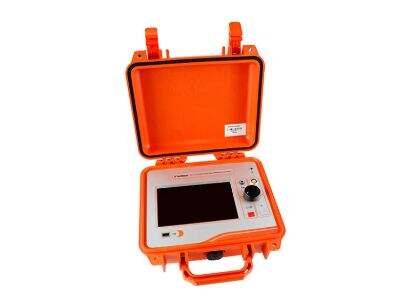বিভিন্ন ধরনের ডিভাইসের জন্য ক্যালিব্রেশন একটি গুরুত্বপূর্ণ বিষয়, যেমন তানবোস ক্যাবল ফল্ট লোকেটর, যা ডিভাইসটিকে স্বাভাবিকভাবে কাজ করতে সক্ষম করে। ক্যালিব্রেট না করা ডিভাইসগুলি অসঠিক ফলাফল দিতে পারে, এবং যখন আপনি কিছু ক্যাবলের ত্রুটি খুঁজে পেতে চান, এটি একটি সমস্যা হতে পারে।
ক্যাবল ফল্ট লোকেটরদের জন্য সঠিক ক্যালিব্রেশনের গুরুত্ব হল আপনার সাইকেল ব্যবহার করার আগে তা ভালো অবস্থায় রয়েছে কিনা তা নিশ্চিত করার গুরুত্বের সমতুল্য।
যদি ব্রেকগুলি খারাপভাবে সমন্বিত হয়, অথবা আপনার কাছে ভাল ব্রেক না থাকে, তাহলে আপনি থামতে পারবেন না। একইভাবে, যদি ক্যাবল ত্রুটি অবস্থান নির্ণায়ক সঠিকভাবে ক্যালিব্রেট না করা হয়, তবে এটি আপনার খোঁজা ক্যাবল ত্রুটি অবস্থান নির্ণয় করতে অক্ষম হতে পারে।
ক্যাবল ত্রুটি অবস্থান নির্ণায়কদের কার্যকারিতা উপর সঠিক ক্যালিব্রেশনের প্রভাব
আপনার ক্যাবল ত্রুটি অবস্থান নির্ণায়কের উপর ক্যালিব্রেশনের প্রভাবকে কেক তৈরি করার সঙ্গে তুলনা করা খুব বেশি অতিরঞ্জিত হবে না। যদি আপনি এতে গুঁড়ো বা চিনি ভুল পরিমাণে দেন, তাহলে আপনার কেকটি ঠিকমতো তৈরি হবে না। একইভাবে, যদি ক্যাবল ত্রুটি অবস্থান নির্ণায়ক সঠিকভাবে ক্যালিব্রেট না করা হয়, তবে ক্যাবল ত্রুটির অবস্থান সম্পর্কে ভুয়া তথ্য দিতে পারে এবং সেই ত্রুটি মেরামত করা কঠিন করে তুলতে পারে।
ক্যাবল ত্রুটি অবস্থান নির্ণায়ক ব্যবহার করার সময় সঠিক পাঠ পাওয়ার জন্য ইউনিটগুলি ক্যালিব্রেট করা হচ্ছে একটি ধাঁধা সমাধান শুরু করার আগে নির্দেশাবলী পড়ার মতোই।
যদি আপনি এমন কোথাও টুকরোটি ঢুকিয়ে দেন যেখানে এটির থাকার কথা নয়, তবে আপনার ধাঁধাটির শেষে ঠিকভাবে দেখতে হবে না। পাশাপাশি, সঠিকভাবে ক্যালিব্রেট করা না হলে ক্যাবল ত্রুটি অবস্থান নির্ণায়ক যন্ত্রটি সঠিক ফলাফল দিতে পারে না যা সেই অনুযায়ী হওয়া উচিত। অন্যদিকে, ভুল সমস্যার সমাধান করলে পরিস্থিতি আরও বিভ্রান্তিকর হয়ে উঠবে এবং ক্যাবলের ত্রুটি সংশোধনে দেরি হবে।
আপনার পছন্দের খেলনা চার্জ ছাড়া খেলা শুরু করেন না যেভাবে, ঠিক সেভাবে ক্যাবল ত্রুটি অবস্থান নির্ণায়কগুলির সর্বোচ্চ কাজ পেতে ক্যালিব্রেশন মূল চাবি।
যদি ব্যাটারি সম্পূর্ণ চার্জ না হয়, তবে খেলনাটি তার সর্বোচ্চ ক্ষমতা প্রদর্শন করতে পারে না। এবং খারাপভাবে ক্যালিব্রেট করা ক্যাবল ত্রুটি অবস্থান নির্ণায়ক এর সর্বোচ্চ ব্যবহার হবে না, যা ক্যাবলের ত্রুটি খুঁজে বার করা এবং সংশোধনের গতি এবং কার্যকারিতা কমিয়ে দিতে পারে।
উদাহরণস্বরূপ, আপনি তুলনা করতে পারেন কীভাবে ভুল ক্যালিব্রেশন ত্রুটি প্রবর্তন করতে পারে এবং কীভাবে ভুল নিয়মের সেট একটি খেলা নষ্ট করে দিতে পারে।
যদি কেউ একই খেলা না খেলে, তাহলে কেউ জিততে পারবে না কারণ কেউই খেলার পদ্ধতিতে একমত হবে না। আর যেমনটা হয় দোষযুক্ত ১১কেভি তারের ত্রুটি অবস্থান নির্ণায়ক যন্ত্র অথবা যেগুলো খুব কম সঠিকভাবে পরিমাপ করা হয়, যখন তথ্যগুলো সঠিক নয়, তখন একজন তারের সমস্যা সমাধানকারী বিভ্রান্ত ও অসন্তুষ্ট হয়ে পড়তে পারে।
সূচিপত্র
- ক্যাবল ফল্ট লোকেটরদের জন্য সঠিক ক্যালিব্রেশনের গুরুত্ব হল আপনার সাইকেল ব্যবহার করার আগে তা ভালো অবস্থায় রয়েছে কিনা তা নিশ্চিত করার গুরুত্বের সমতুল্য।
- ক্যাবল ত্রুটি অবস্থান নির্ণায়কদের কার্যকারিতা উপর সঠিক ক্যালিব্রেশনের প্রভাব
- ক্যাবল ত্রুটি অবস্থান নির্ণায়ক ব্যবহার করার সময় সঠিক পাঠ পাওয়ার জন্য ইউনিটগুলি ক্যালিব্রেট করা হচ্ছে একটি ধাঁধা সমাধান শুরু করার আগে নির্দেশাবলী পড়ার মতোই।
- আপনার পছন্দের খেলনা চার্জ ছাড়া খেলা শুরু করেন না যেভাবে, ঠিক সেভাবে ক্যাবল ত্রুটি অবস্থান নির্ণায়কগুলির সর্বোচ্চ কাজ পেতে ক্যালিব্রেশন মূল চাবি।
- উদাহরণস্বরূপ, আপনি তুলনা করতে পারেন কীভাবে ভুল ক্যালিব্রেশন ত্রুটি প্রবর্তন করতে পারে এবং কীভাবে ভুল নিয়মের সেট একটি খেলা নষ্ট করে দিতে পারে।

 EN
EN
 AR
AR HR
HR CS
CS NL
NL FR
FR DE
DE EL
EL HI
HI IT
IT JA
JA KO
KO NO
NO PL
PL PT
PT RO
RO RU
RU ES
ES SV
SV TL
TL IW
IW ID
ID SR
SR SK
SK UK
UK VI
VI ET
ET HU
HU TH
TH TR
TR FA
FA MS
MS GA
GA HY
HY AZ
AZ UR
UR BN
BN LA
LA MN
MN KK
KK
